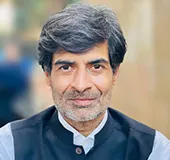Q: The concept of Indo-Pacific is increasingly often positioned as an alternative to the Chinese projects of improving connectivity in Eurasia. How viable is this idea?
A: The Indo-Pacific and Eurasia are not isolated geographical constructs. There is great interdependence between the markets, communities and security concerns of both. A plethora of actors seek to influence the political, economic and security frameworks that will govern these regions. China is undoubtedly chief amongst them.
However, China’s rise has also created new coalitions of states with alternative propositions. Where Beijing wants to globalize its own model of political authoritarianism and state capitalism, countries like the US, EU member states, India, Japan and Australia seek to advance norms based on democracy, multilateralism, good governance and rules-based security.
The “viability” of these competing propositions will depend on which resonates more with the development and security needs of developing states in Eurasia and the Indo-Pacific. In the short term, both will co-exist and compete.
Q: What economic, political and strategic goals are pursued by the United States and its regional partners, first of all, India and Japan? Where are they aligned and where do they diverge?
A:
The US seeks to protect its extant influence in Asia. This implies that the US will support initiatives that improve political freedoms, create free market rules for commerce and adhere to international security norms. Towards this end, it has clearly adopted state postures to compete with China.
Japan, meanwhile shares similar interests. However, it is more inclined to cooperate with China on the BRI to advance its own commercial interests. Japan will instead compete with China on the
normsrelating to infrastructure connectivity—promoting good governance and financial sustainability in the projects it signs onto.
India shares a far more complex relationship with both China and the US. Delhi will not participate in the BRI considering that the initiative undermines its sovereignty and broader ability to exert its own interests. On the other hand, China will rank amongst the largest investors in the Indian economy. Delhi will have to be firm with the political relationship while facilitating integration with China’s economy.
India is partnering with the US in part because there is a convergence of interest in balancing China’s rise and in part because it is a partnership underpinned by shared values. However, both states share different perceptions of the Indo-Pacific. While the US’ mental map ends at West India, India’s stretches from the Western Pacific to East Africa. Both also share different attitudes to Eurasian countries like Iran and Russia.
Q: Should the Belt and Road Initiative and Indo-Pacifica be seen in zero-sum game terms?
A: Currently the BRI and the “free and open” Indo-Pacific are competing initiatives. However, the real choice will be made by developing states, who are leveraging both initiatives to obtain better deals. It’s not inconceivable that in the long term, some multilateral arrangement will accommodate both initiatives.
Q: The Belt and Road Initiative is often accused of blending economic and political goals. Is the same true for Indo-Pacific?
A: Yes, both initiatives undoubtedly blend political and economic goals. As mentioned earlier however, the difference lies in the norms, institutions and partnerships that both seek to advance and protect.
China’s BRI is a unilateral project that advances the interests of one country. The Indo-Pacific strategy meanwhile is inclusive by definition. It must accommodate not only the interests of its guarantors (the Quadrilateral Initiative), but also of all states that are willing to participate in the initiative. It is possessed of cooperative mechanisms that facilitate dialogue and cooperation, as opposed to the BRI which privileges “client-state” models.
Q: Should Russia view Indo-Pacific project as detrimental to its Eurasian initiatives?
A: Counterintuitively, the Indo-Pacific project gives Moscow leverage with China in Eurasia. Currently, Russia is subservient to Chinas’ economy and, by consequence, its political vision. Moscow should recognize that while China may seek a multipolar world, its vision for Eurasia is unipolar. Russia will only benefit if both the Indo-Pacific and Eurasia are truly multipolar in their power structures.
In this, the Russia-India bilateral has a very important role to play. Both countries can facilitate greater synergy between commercial and security initiatives in the Indo-Pacific and Eurasia.
This interview originally appeared in Valdaiclub




 PREV
PREV


